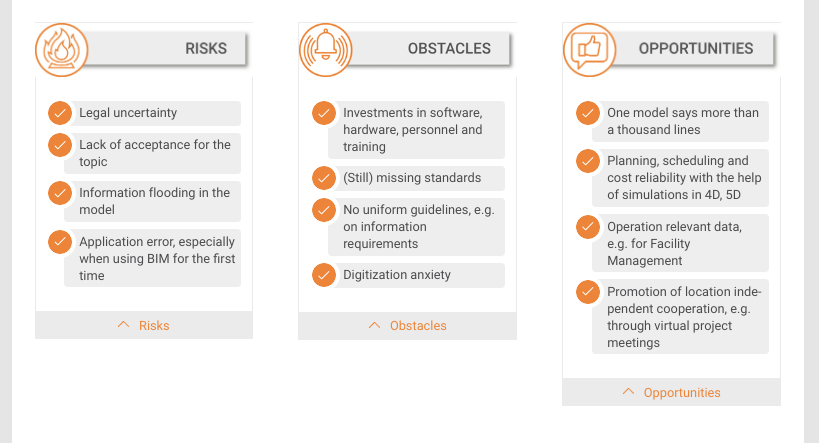Building Information Modeling (BIM) is revolutionizing the architecture, engineering, and construction (AEC) industry worldwide. For many public sector and major projects, BIM has become the required method of working. Yet, despite the increasing acceptance and use of BIM, there are still some barriers to its adoption. The private sector, in particular, has seen an uneven uptake, with the UK organization, NBS, citing a lack of client demand in their 2019 National BIM Report1.
There are several reasons for this, but chief among them is the risk-averse nature of the AEC industry. As with any innovation, there are bound to be risks and barriers to implementing a new working method into standard practice – EDUBIM, a German BIM training provider, has identified several obstacles to effective BIM implementation. However, they have also highlighted the potential opportunities of BIM. The question is, can the opportunities that BIM offers balance out the challenges and create gains in the long-term?
© EDUBIM

The Risks of BIM
Although BIM has existed for several decades, its use has increased significantly in the last few years. As a result, it is natural for there to be some level of perceived risk when considering transitioning to BIM. For example, there may be legal uncertainties as to how BIM affects the contract between the different project stakeholders and how much risk it exposes each party to. There may also be some parties who do not understand what BIM is and how it can benefit the project, who therefore believe that implementing BIM is an unnecessary expense or waste of time.
There are also risks when using BIM on projects, particularly while project teams are first adapting to this new working method. For example, too much time may be spent on creating detailed model information that is not necessary at that stage of the project, and negatively impact the schedule and budget as a result.
Barriers to BIM Implementation
Assuming that the risks are acceptable, there are still several barriers that need to be overcome. The most obvious obstacle to implementing BIM is the investment required not just in software and training, but also potential new hardware requirements and new roles, such as a BIM Coordinator. Even when the transition has been made, there are still many questions about how to apply BIM within a project, with some standards still yet to be agreed. In addition, without a standard set of guidelines, what is required by one client may not be suitable for another. Some clients may even feel that BIM is not applicable to their work because it is not a large or complex project.
The Opportunities Provided by BIM
While the risks and barriers are serious considerations, the fact remains that the opportunities that BIM offers for enhanced collaboration, coordination, and communication are significant. A 3D model can create a much more informative picture than a thousand lines in CAD, helping everyone on the project team to clearly envision the structure and how their discipline fits within the whole. Planning, scheduling, and cost estimation are substantially improved with the help of simulations that can accurately forecast construction schedules and cost profiles – also known as 4D and 5D BIM respectively.
The BIM model also has value after the construction process has finished, as either an operations or facilities management model, or even for future refurbishment, extension, or demolition works. And in an age where project teams can be spread across several countries, BIM also provides a platform for efficient working and project management, using the model as a central, shared resource of project information and communication. It is clear that the benefits of BIM – such as lower costs, fewer errors, and faster delivery times – can quickly overcome the barriers and reduce the risk of adoption.
Leveraging the Power of BIM
As with any new technology, there are early adopters as well as those who require more convincing. While the risks and barriers may seem high, the question that companies who do not adopt BIM now must ask themselves is: what are the costs and implications of not implementing BIM? And as BIM becomes the accepted method of designing, delivering, and managing projects, can our company afford to be left behind? If the answer to the latter question is no, why not consider downloading a free, 30-day trial of ALLPLAN to see how easy and intuitive the switch to BIM can be.




